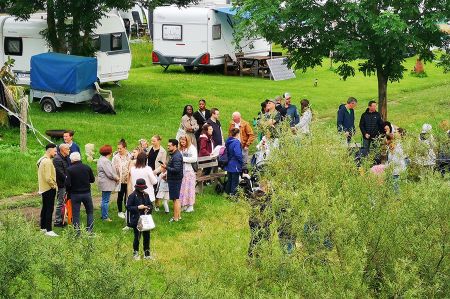Baptism in the Ruhr river - a special experience
- Written by Portal Editor
A morning gathering of numerous people with little camping affinity at the campsite on the Ruhr had caught our attention and so when the groundskeeper appeared it was clear that we would ask what kind of group this was.
Today a baptism of several people is taking place here in the Ruhr, was his answer. Our interest was immediately aroused.
Full body baptism is common practice in some free churches
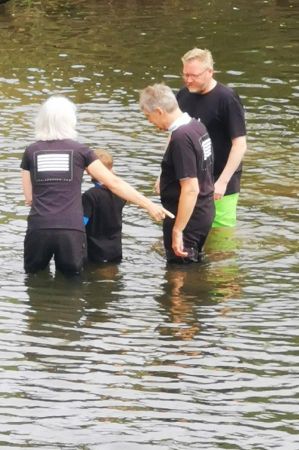 Of course we wanted to know more, including whether we could ask questions and take photos. We were warmly invited to take part in the event. Now we were excited to see what would happen next. The group gathered, loudspeaker technology was set up and the first announcements were made. One of the participants gave a speech that could have been a sermon. There was a lot of singing and every action was accompanied by applause. In general, the relaxed atmosphere in the community seemed to be part of the daily routine, far from a classic church. Our questions were answered openly and always politely, and so the morning was a learning process with numerous new insights.
Of course we wanted to know more, including whether we could ask questions and take photos. We were warmly invited to take part in the event. Now we were excited to see what would happen next. The group gathered, loudspeaker technology was set up and the first announcements were made. One of the participants gave a speech that could have been a sermon. There was a lot of singing and every action was accompanied by applause. In general, the relaxed atmosphere in the community seemed to be part of the daily routine, far from a classic church. Our questions were answered openly and always politely, and so the morning was a learning process with numerous new insights.
We first learned that so-called immersion baptisms, or more understandably, full-body baptisms, are practiced in some modern free churches, but were actually the original form of Christian baptism. The fact that baptism in the early church was performed by immersion is particularly clear from the Bible: the baptized person, by immersing himself in the water, participates in the death of Jesus Christ, and by emerging from the water, participates in the resurrection. The act of baptism creates a kind of community of fate with Jesus.
Ulrich Wilckens once commented: During baptism by immersion, people have the elementary experience of sinking helplessly in the flood of water and being dependent on help and rescue; "and the experience of baptism as the reality of this salvation then becomes the basis of a fundamental trust in the divine saving power that determines one's whole life and overcomes it in the midst of all helpless fear."
Baptism by immersion remained the normal form of baptism for a long time.
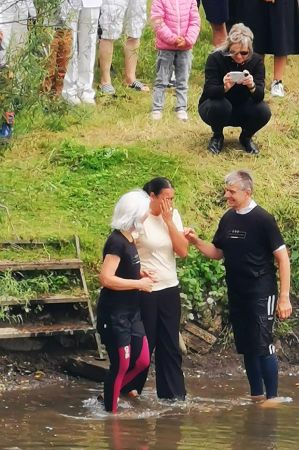 Christianity is known to have its origins in the eastern Mediterranean, where a bath in cold water has an invigorating and refreshing aspect due to the climatic conditions. In the early church, baptism was carried out in "living water". The Didache states the following about the practice of baptism (the Didache is also generally referred to as the instruction of the faithful after baptism, in contrast to the kerygma, the instruction of the catechumens before baptism):
Christianity is known to have its origins in the eastern Mediterranean, where a bath in cold water has an invigorating and refreshing aspect due to the climatic conditions. In the early church, baptism was carried out in "living water". The Didache states the following about the practice of baptism (the Didache is also generally referred to as the instruction of the faithful after baptism, in contrast to the kerygma, the instruction of the catechumens before baptism):
When you have said all the above, "baptize in the name of the Father and of the Son and of the Holy Spirit" in running water. But if you do not have running water, then baptize in another water; if you cannot do it in cold water, do it in warm water. If you don't have either, pour water on the head three times "in the name of the Father and of the Son and of the Holy Spirit." Before baptism, the person doing the baptism, the person being baptized and whoever else can should fast; let the person being baptized fast a day or two beforehand.
Justin wrote in the 2nd century that those being baptized were "led to a place where there is water and are born again in a kind of rebirth... for in the name of God, the Father and Lord of all things, and in the name of our Savior Jesus Christ and of the Holy Spirit, they then bathe in water."
The Epistle of Barnabas mentions that they descended into the baptismal water and ascended again.
Egyptian church order Traditio Apostolica?
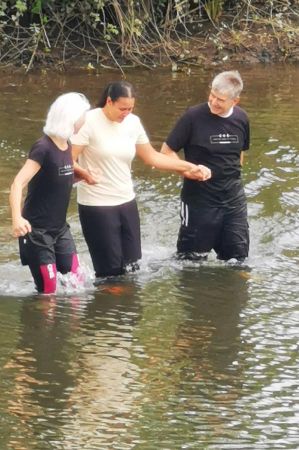 Full-body baptism was also widespread in the Orthodox Church, while in the Catholic and Protestant churches baptism by sprinkling water on the head of the person being baptized has become the norm.
Full-body baptism was also widespread in the Orthodox Church, while in the Catholic and Protestant churches baptism by sprinkling water on the head of the person being baptized has become the norm.
The Traditio Apostolica, an originally Egyptian church order from the 4th century, requires a baptismal font with steps. The priest, person being baptized and deacon stepped into the water after the anointing ritual. The priest asked the three baptismal questions and after each affirmative answer the deacon poured water over the person being baptized. Deaconesses assisted in the baptism of women.
If the pool is one meter deep, for example, it must be taken into account that the pool was probably not filled to the brim. One can only speculate about how the baptism took place in these pools.
One reconstruction assumes that the priest climbed into the water with the person being baptized, then stood in the side arm of the cross-shaped basin and from there performed the baptism by immersion.
Another idea is that assistants climbed into the water during the baptism and helped the person being baptized to fall backwards and lie flat on the floor of the baptismal font. This would not have been practical in all ancient baptismal fonts.
Baptism rituals still common among the Mandaeans today
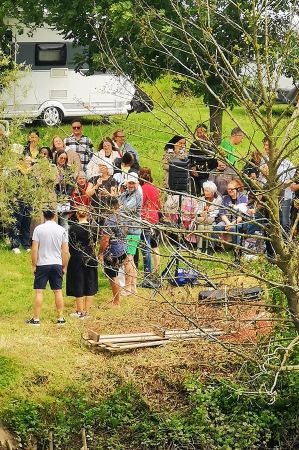 For the Mandaean religious community, flowing water means life. Flowing water also symbolizes God. This previously unknown religious community from Iraq and Iran even builds its prayer houses on rivers. In addition, every Mandaean should try to live near a river. It is therefore considered a great sin to pollute flowing water. The Mandaeans believe in the immortality of the soul and in a god. They call him "The Living One" or "King of Light". Their last prophet was John the Baptist.
For the Mandaean religious community, flowing water means life. Flowing water also symbolizes God. This previously unknown religious community from Iraq and Iran even builds its prayer houses on rivers. In addition, every Mandaean should try to live near a river. It is therefore considered a great sin to pollute flowing water. The Mandaeans believe in the immortality of the soul and in a god. They call him "The Living One" or "King of Light". Their last prophet was John the Baptist.
Yassmen Yahya, the chair of the Synod of the Mandaeans in Australia:
“Before we can practice the ritual of baptism in running water, we need the river’s permission. Only then do the priests begin the ceremony, which is held in Aramaic. You stand in the water with the priest, offer him your right hand and make a promise to do good deeds from now on. That means, for example, helping those in need and not harming other people. The priest then submerges the person being baptized three times.
However, it is a good deed for Mandaeans to throw leftover food into the river. This is supposed to feed the creatures in the river.
It was a real shame that it was so rainy that day, because normally a communal meal would have taken place on the square after the baptism ceremony, the groundskeeper later explained. Benches and tables were to be set up in advance. Now the communal meal was moved to the community centre, and we were also invited. In general, people seemed to be very interested in demonstrating a fairly transparent, open society, and there was no thought of "conversion."
Please read as well:
Morović - sleepy small town on Bosut and Studva in Serbia
Cycle tour to the Burgaltendorf castle ruins from Essen-Horst
-
 Baptism on the Ruhr river
Baptism on the Ruhr river
Baptism on the Ruhr river
Baptism on the Ruhr river
-
 Baptism on the Ruhr river
Baptism on the Ruhr river
Baptism on the Ruhr river
Baptism on the Ruhr river
-
 Baptism on the Ruhr river
Baptism on the Ruhr river
Baptism on the Ruhr river
Baptism on the Ruhr river
-
 Baptism on the Ruhr river
Baptism on the Ruhr river
Baptism on the Ruhr river
Baptism on the Ruhr river
-
 Baptism on the Ruhr river
Baptism on the Ruhr river
Baptism on the Ruhr river
Baptism on the Ruhr river
-
 Baptism on the Ruhr river
Baptism on the Ruhr river
Baptism on the Ruhr river
Baptism on the Ruhr river
-
 Baptism on the Ruhr river
Baptism on the Ruhr river
Baptism on the Ruhr river
Baptism on the Ruhr river
-
 Baptism on the Ruhr river
Baptism on the Ruhr river
Baptism on the Ruhr river
Baptism on the Ruhr river
-
 Baptism on the Ruhr river
Baptism on the Ruhr river
Baptism on the Ruhr river
Baptism on the Ruhr river
-
 Baptism on the Ruhr river
Baptism on the Ruhr river
Baptism on the Ruhr river
Baptism on the Ruhr river
-
 Baptism on the Ruhr river
Baptism on the Ruhr river
Baptism on the Ruhr river
Baptism on the Ruhr river
-
 Baptism on the Ruhr river
Baptism on the Ruhr river
Baptism on the Ruhr river
Baptism on the Ruhr river
-
 Baptism on the Ruhr river
Baptism on the Ruhr river
Baptism on the Ruhr river
Baptism on the Ruhr river
-
 Baptism on the Ruhr river
Baptism on the Ruhr river
Baptism on the Ruhr river
Baptism on the Ruhr river
-
 Baptism on the Ruhr river
Baptism on the Ruhr river
Baptism on the Ruhr river
Baptism on the Ruhr river
https://www.alaturka.info/en/culture/religion/6676-baptism-in-the-ruhr-river-a-special-experience#sigProId7b3484ce87
